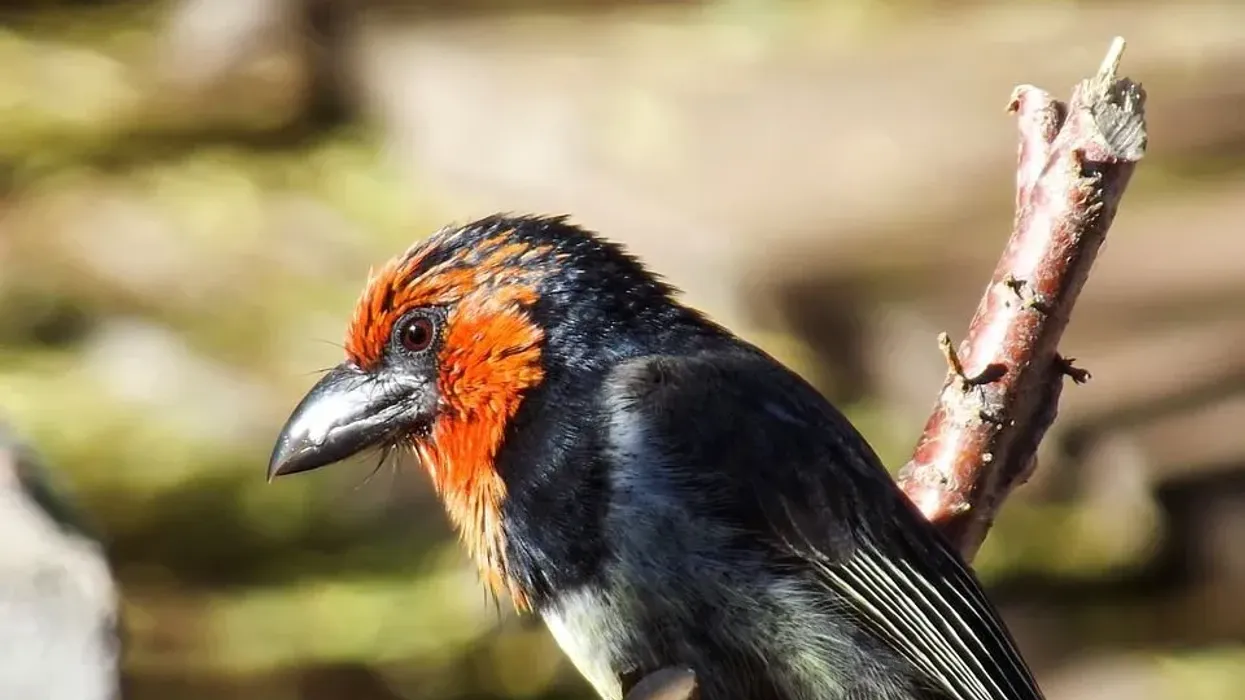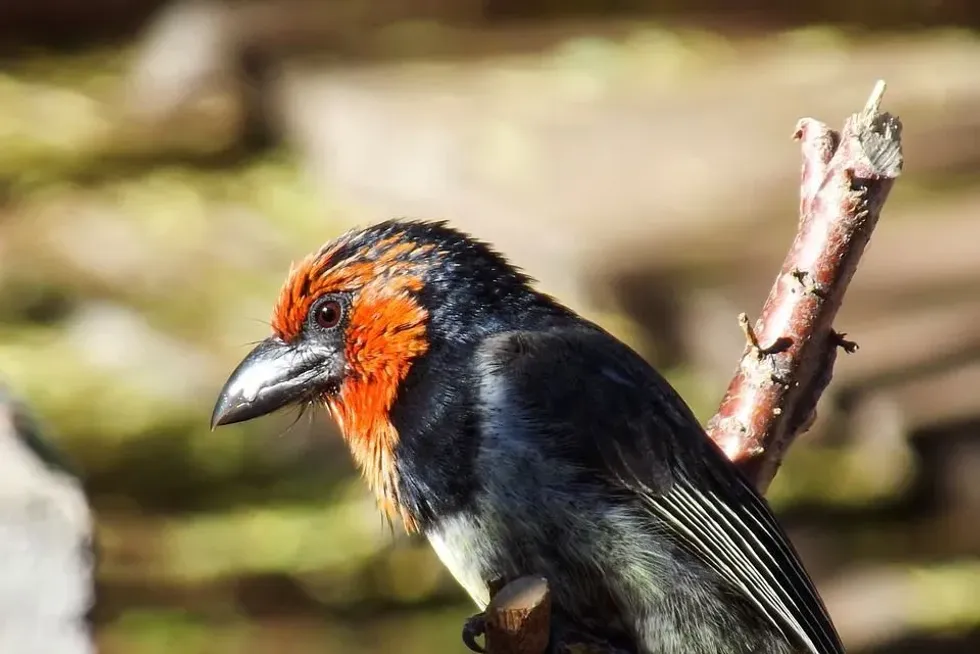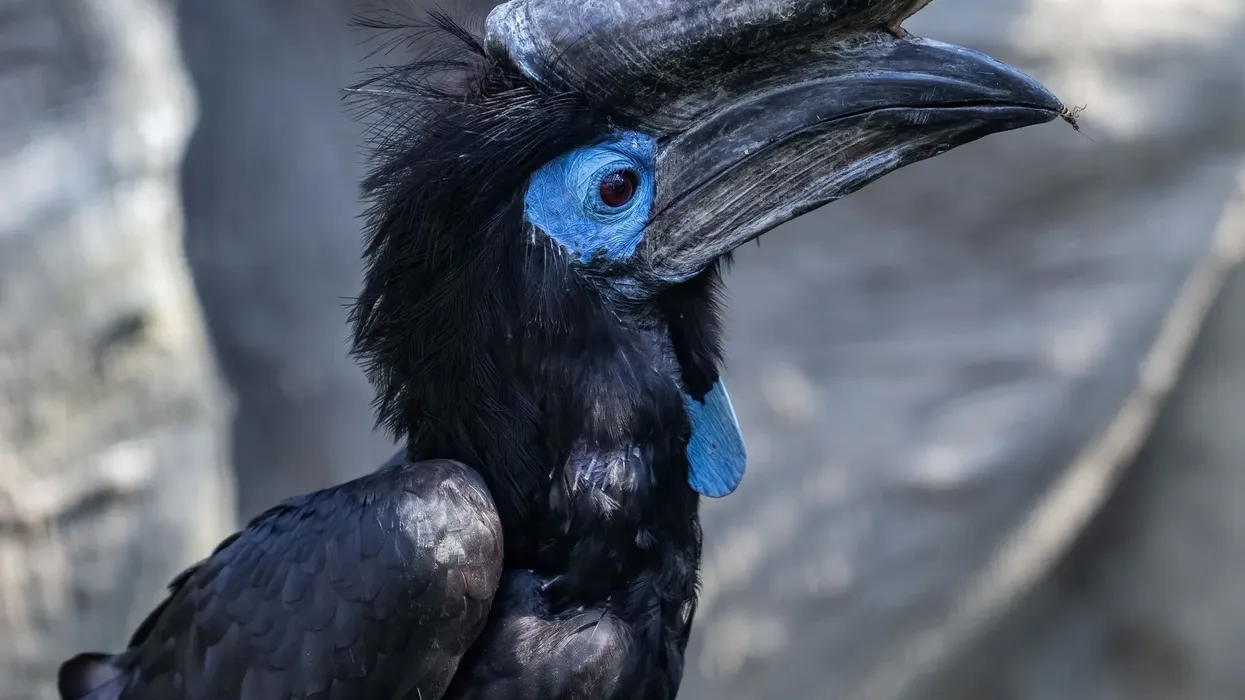The black-collared barbet is a species of Sub-Saharan African birds found in Namibia and parts of Central and southern Africa. They belong to the Lybiidae family and their scientific name is Lybius torquatus.
Mostly found in the wild in Africa, they are known for the duet song that makes a 'puddly' sound. A pair of barbets is normally found performing their song perched high on fruit trees, primarily in South Africa, Tanzania, and Uganda.
They live in protected national parks like the Kololo National Park in South Africa. This bird is not a migratory bird and stays near the place that it is born.
Their nest is built into the ground, known as nest holes. The black-collared barbet's diet consists of fruits and fruit nectar in the wild.
They sometimes feed on lizards, frogs, and insects like centipedes but this is uncommon. The nestling of this bird does not feed on insects as they have yet to develop a broad, heavy bill.
To learn about some other interesting birds, check out the flycatcher and red-backed shrike.
Black-Collared Barbet Interesting Facts
What type of animal is a black-collared barbet?
The black-collared barbet (Lybius torquatus) is a species of bird found in Sub-Saharan Africa.
What class of animal does a black-collared barbet belong to?
The Lybius torquatus (black-collared barbet) belongs to the Aves or bird class of animals. Additionally, the classification includes their phylum Chordata, their order Piciformes, their genus Lybus, and their family, which is Lybiidae. These are primarily found in Africa.
How many black-collared barbets are there in the world?
There is no exact number for the populations of black-collared barbet (Lybius torquatus) birds.
Where does a black-collared barbet live?
This species of Sub-Saharan African birds are found in Central and southern Africa. The black-collared barbet range map includes countries like Kenya, Botswana, Namibia, Zimbabwe, and Mozambique.
What is a black-collared barbet's habitat?
The black-collared barbet (Lybius torquatus) lives in the savannah, forest, grassland, and inland wetlands of Central and southern Africa throughout Angola, Namibia, Botswana, Mozambique, Zimbabwe, Kenya, and Tanzania.
Who do black-collared barbets live with?
The black-collared barbet (Lybius torquatus) is a species of Sub-Saharan African bird. They are part of the family Lybiidae and they are solitary in nature, which is similar to most of its bird family.
How long does a black-collared barbet live?
The lifespan of the black-collared barbet (Lybius torquatus) is not known.
How do they reproduce?
The breeding season of the black-collared barbet (Lybius torquatus) is from August to April. This species of sub-Saharan African birds has specific breeding months based on the country they reside.
For example, the breeding season in Rwanda is in April to May and in Zimbabwe and Angola, it occurs September to December. The male that is on search for a female tries to impress the female by bill-tapping, song duets, and displays of flight strengths.
They will sometimes perch on top of trees and try to make eye contact with each other as they call. A pair of Sub-Saharan African birds share the responsibility for feeding their young.
Male and female birds dig deep holes into the ground to make their nest, as their eggs often fall prey to the lesser honeyguide (Indicator minor) and can delay breeding. The lesser honeyguide will sometimes eat the eggs from the holes and take over the nest.
The diet of the young birds consists of fruit nectar fed through the beak. Feeding insects to the young is uncommon. This species of bird can lay up to four clutches in one season.
What is their conservation status?
The Lybius torquatus (black-collared barbet) is in the Least Concern category according to the IUCN Red List for Threatened Species.
Black-Collared Barbet Fun Facts
What do black-collared barbets look like?
The Lybius torquatus (black-collared barbet) found in Africa has a colorful neck and head, with bits of yellow, red, and black. Their stomach is pale yellow and red and their wings are brown with hints of yellow in the wing edges.
They have a broad, heavy bill which is predominantly used to eat fruits and fruit nectar in the wild.
How cute are they?
Compared to other Sub-Saharan African bird species, the black-collared barbet is ranked high in our cuteness quotient. Its medium-sized body and small wings make this bird very cute.
How do they communicate?
This species of Sub-Saharan African birds is known for its duet calls while perched on the tops of trees. They do not make solitary calls.
The duet starts with a call from trees that seems to sound like a snarl, followed by wing-flicking. According to several sources, a pair of birds sound like they are simultaneously repeating the word 'puddly' while they duet from trees.
How big is a black-collared barbet?
The Lybius torquatus (black-collared barbet) is about 6.8-7.4 in (17.2-18.7 cm) long. They are considered to be one of the smaller barbets compared to some of the other barbet species like the toucan barbet.
How fast can a black-collared barbet fly?
There is no official data regarding the flight speed of the Lybius torquatus (black-collared barbet).
How much does a black-collared barbet weigh?
The weight of the Lybius torquatus (black-collared barbet) depends on which region of Africa they reside. The northern species weighs 1.2-1.6 oz.(34-45.3 g) and the southern species weighs 1.5-2.8 oz. (42.5-79.3 g).
What are the male and female names of the species?
Male and female black-collared barbet birds have no specific name.
What would you call a baby black-collared barbet?
A baby black-collared barbet bird is called a baby or nestling.
What do they eat?
The black-collared barbet's diet consists of fruits (grapes, guava, and fig) and fruit nectar. They are sometimes observed feeding on insects, centipedes, lizards, frogs, and geckos, but this is uncommon.
Are they poisonous?
No, black-collared barbets are not poisonous at all.
Would they make a good pet?
The black-collared barbet is a species of bird that is best suited for the wild and not normally kept as a pet. In South Africa, you are required to have a permit. They are normally seen in pairs rather than solitary in the game reserves of Namibia, Kenya, and Botswana.
Did you know...
The black-collared barbet call is usually performed with a pair facing each other as they start the duet.
The first description of the black-collared barbet was given by the French zoologist Charles Henri Frédéric Dumont de Sainte-Croix.
A crested barbet, part of the barbet family, is attracted to the large birdhouses that people leave in their gardens.
Do black-collared barbets migrate?
No, this species of barbet does not migrate.
Are black-collared barbets endangered?
This species of bird that is found in Central and southern Africa are not endangered. According to the IUCN Red List, they are in the Least Concern category. These black-collared barbets are mostly seen in protected game parks, like the Kololo National Park in South Africa.
Here at Kidadl, we have carefully created lots of interesting family-friendly animal facts for everyone to discover! For more relatable content, check out these giant cowbird facts and ani bird facts for kids on the web.
You can even occupy yourself at home by coloring in one of our free printable bird coloring pages on the web.
Second image by Bernard Dupont from France










